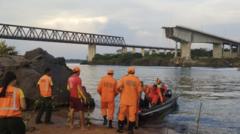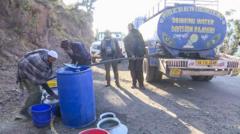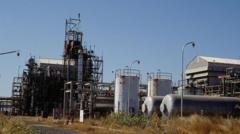A tragic bridge collapse in northern Brazil has left multiple fatalities and sparked fears of toxic contamination in local waterways.
Deadly Bridge Collapse in Brazil Raises Concerns Over Chemical Contamination

Deadly Bridge Collapse in Brazil Raises Concerns Over Chemical Contamination
Collapse claims lives and endangers water supply while search and rescue efforts continue.
The collapse of the Juscelino Kubitschek de Oliveira bridge in northern Brazil has resulted in a human tragedy and potential environmental crisis. The incident occurred on Sunday afternoon, taking the lives of at least four individuals and leaving more than ten reported missing. The bridge, which spans the Tocantins river and connects the states of Tocantins and Maranhão, failed under the weight of several vehicles, including trucks laden with thousands of liters of hazardous chemicals such as pesticides and sulphuric acid.
Witness accounts describe a dramatic scene, with local councillor Elias Junior documenting the bridge's deterioration before its catastrophic failure. He expressed disbelief at witnessing the collapse, stating, "I never expected the bridge to actually collapse." In total, eight vehicles fell into the river, including three carrying volatile substances, raising immediate concerns about the safety of the water supply.
As rescue operations unfold from boats, the fire service has confirmed the recovery of four bodies, including that of a female truck driver and an 11-year-old girl. Authorities have urged residents in the nearby cities of Estreito and Aguiarnopolis to refrain from drawing water from the river until the extent of potential contamination can be assessed.
Currently, diving operations have been suspended as officials evaluate the situation, and there are ongoing efforts to rescue any survivors who may still be trapped. The bridge itself, over 1,600 feet long and completed in the 1960s, serves as a critical connection for traffic between the two states. The tragedy is a stark reminder of the need for infrastructure safety and monitoring.
Witness accounts describe a dramatic scene, with local councillor Elias Junior documenting the bridge's deterioration before its catastrophic failure. He expressed disbelief at witnessing the collapse, stating, "I never expected the bridge to actually collapse." In total, eight vehicles fell into the river, including three carrying volatile substances, raising immediate concerns about the safety of the water supply.
As rescue operations unfold from boats, the fire service has confirmed the recovery of four bodies, including that of a female truck driver and an 11-year-old girl. Authorities have urged residents in the nearby cities of Estreito and Aguiarnopolis to refrain from drawing water from the river until the extent of potential contamination can be assessed.
Currently, diving operations have been suspended as officials evaluate the situation, and there are ongoing efforts to rescue any survivors who may still be trapped. The bridge itself, over 1,600 feet long and completed in the 1960s, serves as a critical connection for traffic between the two states. The tragedy is a stark reminder of the need for infrastructure safety and monitoring.



















